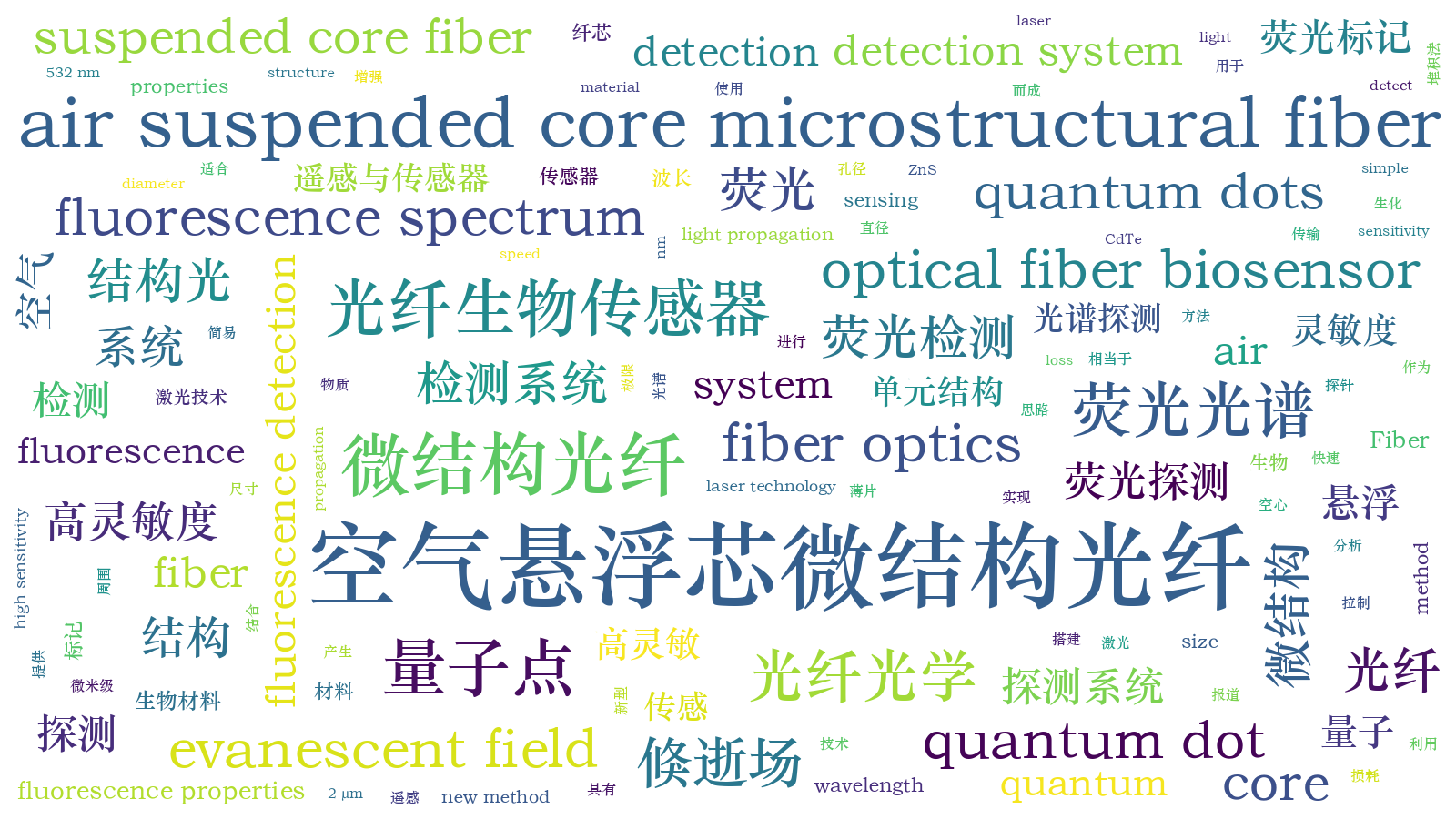基于空气悬浮芯微结构光纤的高灵敏度荧光检测系统  下载: 791次
下载: 791次
1 引言
目前,光纤传感技术在铁路、桥梁、石油、生物化学[1-2]等行业有着非常广泛的应用。随着光纤制造技术的发展,微结构光纤因其优异的特性而在生物化学传感探测方面备受瞩目。基于倏逝场技术的微结构光纤可以同时实现长距离信号传输和高灵敏度探测。微结构光纤具有微米级别的微孔,这种微孔可作为待测物的微型储存室,从而使待测物避免外界环境的干扰[3]。另外,微结构光纤可以由单种材料拉制而成,这相较于普通光纤可以避免外界温度和化学物质的干扰[4]。
近几年,通过改进微结构光纤的结构与材料,使光场与待测物的重合得到了大幅增加,与此同时也提升了微结构光纤的检测灵敏度。例如,光子带隙型光纤(PBGF)[5-13]的特殊结构使其倏逝场与微孔中待测物的相互作用重合度得到了大幅提升,从而增加了其在传感探测方面的灵敏度。相较于拉锥纳米线光纤[14-19],PBGF具有相互作用距离长、待测物需求量少、易操作、避免环境干扰等优势。但是由于大多数PBGF存在相对有限的传输带宽,所以探测时需要激发波长与发射波长比较接近,这大大限制了此类光纤的应用范围。在此情况下,更多特种微结构光纤涌现出来。例如:英国南安普顿大学发明了一种纤芯大小为光波长的悬浮芯特种微结构光纤,此光纤具有较宽的传输波段,在生物化学传感方面具有非常广阔的应用前景[20-21];澳大利亚阿德莱德大学的Monro研究组研制了芯径在微米结构的多孔微结构光纤,并利用该光纤进行了一系列生物、化学、材料方面的高灵敏度探测[22-27]。
本文介绍了一种新型的微结构光纤——空气悬浮芯微结构光纤,此光纤的纤芯直径约为2 μm。因为纤芯尺寸和光波长接近,当光在纤芯中传输时,纤芯周围就会产生较强的倏逝场。通过检测倏逝场与待测物相互作用产生的信号可以实现对待测物的检测。本课题组以这种新型微结构光纤作为传感探针搭建了一套荧光光谱探测仪,并利用此探测仪成功实现了对量子点荧光光谱的传感探测。因为量子点是一种重要的生物标记材料[24-25],该技术将为生物分子(比如蛋白质、核酸等)的灵敏检测提供新思路。
2 光纤拉制与损耗测试
空气悬浮芯微结构光纤预制棒以硼硅酸盐软玻璃材料为主,通过薄片堆积法[20]制备而成,其中纤芯和支撑片的材料分别为Schott N-BK7和Schott D263T玻璃,如
预制棒在拉丝塔上进行预拉制得到小尺寸的预制棒,

图 1. (a)采用堆积法制备的预制棒;(b)预制棒的扫描电镜(SEM)图
Fig. 1. (a) Image of preform prepared by stack method; (b) SEM image of preform
制作好的预制棒最终在光纤拉丝塔上拉制形成空气悬浮芯光纤,一次性可以拉制100 m长的光纤。悬浮芯光纤的横截面如

图 2. 空气悬浮芯光纤横截面的形貌。(a)(b)光学显微镜图;(c)(d) SEM图
Fig. 2. Cross-section images of air suspended core fiber. (a)(b) Optical microscopy images; (c)(d) SEM images
光纤拉制成功后,使用Cutback方法测量悬浮芯光纤在532 nm波长处的传输损耗,结果如

图 3. 悬浮芯光纤在532 nm波长处的传输损耗图
Fig. 3. Propagation loss of air suspended core fiber at the wavelength of 532 nm
通过上述分析可以得出,由于悬浮芯光纤的纤芯尺寸与光波长相当,所以当光在纤芯中传输时,纤芯周围就会产生较强的倏逝场,此倏逝场会与纤芯周围的待测物相互作用而产生检测信号。另外,悬浮芯光纤自带微米级微孔,所需待测物的体积仅为纳升量级,所以可以推知这种空气悬浮芯光纤在探测生化物质方面具有灵敏度高、所需待测物体积小(纳升量级)、可避免污染等优势。
3 实验装置
利用上述光纤作为探针搭建了一套荧光光谱探测系统,实验装置如
实验中使用的悬浮芯光纤长度约为10 cm,待测物量子点悬浮液通过毛细作用被吸入悬浮芯光纤的微孔中,待测物充满整个光纤所需时间不到30 s,计算得到光纤充满时所需液体仅为62 nL左右,悬浮芯光纤填充前后的纵截面对比如

图 5. 悬浮芯光纤(a)未充入和(b)充入量子点悬浮液后的纵截面
Fig. 5. Longitudinal section of air suspended core fiber (a) unfilled and (b) filled with quantum dots suspension
4 实验结果与分析
在使用悬浮芯光纤探测量子点荧光光谱之前,首先在酶标仪上测量量子点的荧光光谱,所测量子点悬浮液的浓度为1 μmol/L,设量子点的激发波长为532 nm,测量结果如
接下来使用

图 6. 酶标仪测得的量子点的荧光光谱
Fig. 6. Fluorescence spectrum of quantum dots measured by a microplate reader
100,50,10,5,2.5 nmol/L的量子点悬浮液进行探测,光纤探针长度为(10±1) cm,激光抽运功率为340 μW左右。为了消除因光纤端面切割不均匀而导致的误差,通过调整抽运功率来保证耦合进光纤纤芯中的功率相同。在光纤长度相同的情况下,保证光纤末端的输出功率相同。本实验设定末端功率为100 μW,光谱仪探测积分时间为1 s。
实验中首先对浓度为100 nmol/L的量子点悬浮液进行探测,测得的量子点的荧光光谱如

图 7. 悬浮芯光纤测得的不同浓度悬浮液中量子点的(a)原始荧光光谱和(b)归一化荧光光谱
Fig. 7. (a) Raw and (b) normalized fluorescence spectra of quantum dots in suspension with different concentrations measured by air suspended core fiber
测得的量子点荧光强度(峰值强度和面积积分强度)与浓度呈现良好的线性关系,如

图 8. 悬浮芯光纤测得量子点荧光(a)峰值强度与(b) 600~800 nm面积积分强度与浓度的线性关系
Fig. 8. Linear relation between the concentration and (a) fluorescence peak intensity and (b) 600-800 nm area integral intensity of quantum dots measured by air suspended core fiber
为了证明所建系统的普适性,本研究还对常用荧光染料罗丹明B的荧光光谱进行了测定,并且对罗丹明B的荧光漂白性能进行了检测,结果见
纤芯的长度代表了待测物与纤芯周围光场相互作用的纵向距离,本研究测量了不同长度悬浮芯光纤对量子点荧光强度的影响。
首先将抽运光耦合进长度为92 cm的悬浮芯光纤中,将100 nmol/L的量子点悬浮液充入光纤中,然后使用Cutback法逐次切割光纤的尾端,得到利用不同长度悬浮芯光纤测得的量子点的荧光强度,结果如

图 10. (a)不同长度光纤测得的量子点的荧光光谱;(b)荧光强度与光纤长度的拟合曲线
Fig. 10. (a) Measured fluorescence spectra of quantum dots using different lengths of fiber; (b) fitting curve of fluorescence intensity and fiber length
5 结论
首先介绍了一种新型结构的微结构光纤——空气悬浮芯光纤,然后以悬浮芯微结构光纤作为探针搭建了一套简易的荧光光谱仪,并利用这套装置采用前向探测法对生物标记材料CdTe/CdS/ZnS核壳量子点的荧光光谱进行了探测。实验结果显示,此装置对量子点的探测极限是1 nmol/L左右,即可以探测到的量子点个数约为3.78×107,这已经达到了高灵敏度探测器的水平。另外,此光纤所需的待测物体积仅为纳升量级,在探测时可使待测物与外部环境隔离,防止待测物被污染,以便进行精准探测。此装置可以用于荧光材料(量子点、荧光染料等)标记的生物分子的检测,比如病原性DNA、蛋白质或者抗体,甚至可以用于荧光标记的肿瘤细胞的检测,具有高灵敏度、所需待测物少(纳升量级)、成本低、紧凑性好等优点。
[1] 黄惠杰, 翟俊辉, 任冰强, 等. 光纤倏逝波生物传感器及其应用[J]. 光学学报, 2003, 15(4): 652-655.
黄惠杰, 翟俊辉, 任冰强, 等. 光纤倏逝波生物传感器及其应用[J]. 光学学报, 2003, 15(4): 652-655.
[2] 黄惠杰, 翟俊辉, 赵永凯, 等. 多探头光纤倏逝波生物传感器及其性能研究[J]. 中国激光, 2004, 31(6): 718-722.
黄惠杰, 翟俊辉, 赵永凯, 等. 多探头光纤倏逝波生物传感器及其性能研究[J]. 中国激光, 2004, 31(6): 718-722.
[7] Bise RT, Windeler RS, Kranz KS, et al. Tunable photonic band gap fiber[C]. Optical Fiber Communication Conference and Exhibit, 2002: 466- 468.
Bise RT, Windeler RS, Kranz KS, et al. Tunable photonic band gap fiber[C]. Optical Fiber Communication Conference and Exhibit, 2002: 466- 468.
[10] 许震宇, 张若京, 龚益玲. 光子晶体压力传感器的基本原理[J]. 物理学报, 2004, 53(3): 724-727.
许震宇, 张若京, 龚益玲. 光子晶体压力传感器的基本原理[J]. 物理学报, 2004, 53(3): 724-727.
[11] MagalhaesF, Carvalho JP, Ferreira LA, et al. Methane detection system based on wavelength modulation spectroscopy and hollow-core fibres[C]. IEEE Sensors Conference, 2008: 1277- 1280.
MagalhaesF, Carvalho JP, Ferreira LA, et al. Methane detection system based on wavelength modulation spectroscopy and hollow-core fibres[C]. IEEE Sensors Conference, 2008: 1277- 1280.
[13] 王若琪, 姚建铨, 周睿, 等. 填充混合液体的光子晶体光纤温度传感研究[J]. 光电子·激光, 2011, 22(11): 1609-1612.
王若琪, 姚建铨, 周睿, 等. 填充混合液体的光子晶体光纤温度传感研究[J]. 光电子·激光, 2011, 22(11): 1609-1612.
[22] Ebendorff-HeidepriemH, PetropoulosP, MooreR, et al. Fabrication and optical properties of lead silicate glass holey fibers[J]. Journal of Non-Crystalline Solids, 2004, 345/346: 293- 296.
Ebendorff-HeidepriemH, PetropoulosP, MooreR, et al. Fabrication and optical properties of lead silicate glass holey fibers[J]. Journal of Non-Crystalline Solids, 2004, 345/346: 293- 296.
Article Outline
张炤, 王秀翃, 乔鹏飞, 刘倩倩, Lang Marion, 冯宪, 王璞. 基于空气悬浮芯微结构光纤的高灵敏度荧光检测系统[J]. 中国激光, 2018, 45(5): 0510006. Zhang Zhao, Wang Xiuhong, Qiao Pengfei, Liu Qianqian, Lang Marion, Feng Xian, Wang Pu. High Sensitivity Fluorescence Detection System Based on Air Suspended Core Microstructural Fiber[J]. Chinese Journal of Lasers, 2018, 45(5): 0510006.








